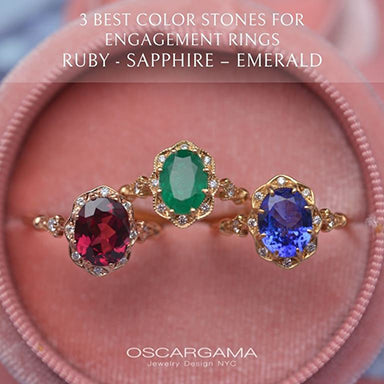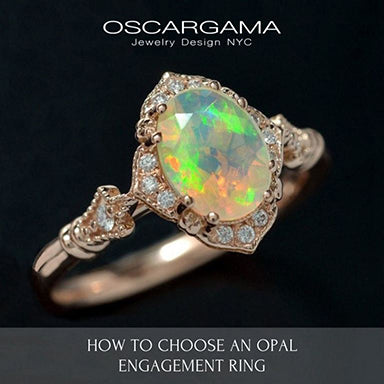So, you’re engagement ring shopping and you’ve come to the question of what metal is best for your future fiance's engagement ring. Here’s a little break down of the three most popular metals for engagement rings so that you can make an informed decision!
Gold is classic engagement ring metal. It’s strong, beautiful, and works well with all skin tones. The downside to gold is that it can scratch and dent more easily than other metals.
Platinum is a newer metal for engagement rings, but it’s quickly become a popular choice because it’s so strong and durable. Platinum engagement rings are beautiful and hypoallergenic, making them aKnowing the principles of evaluating precious metals, their properties and their differences will help you make an informed decision when you are shopping for an engagement ring and choose the one that is right for you. With this blog, we will give you a good idea in how to figure it out.
A few facts about precious metals
Initially, only two metals were considered noble - gold and silver, but in the 18th century this list was expanded to platinum and elements belonging to the platinum group.
Today, 8 elements are considered noble metals, such as gold, platinum, silver, palladium, as well as platinum elements: rhodium and osmium, iridium and ruthenium.

The area of their application is quite extensive. In ancient times, they were used in jewelry and to produce coins. In the modern world, these metals are used in the automotive industry, glass industry (liquid crystal screens, fiberglass, microelectronic optics), the nuclear industry, dentistry, petrochemical production, biomedicine, aerospace instrumentation, jewelry, coinage, electronics, radio technology, photography, pharmacology and much more.
So, what is the difference between noble (precious) metals from other metals?
Noble metals are the most chemically resistant, they are resistant to corrosion and do not oxidize in air, they have special plasticity, high refractoriness and thermal conductivity. They continue to shine after being in water for a long time, do not succumb to hydrochloric acid and high temperatures. For such chemical resistance, beautiful appearance and luster of products inherent in perfection, they are called noble metals. This is a distinctive feature of other known metals. The reserves of such metals in nature are small, they are found in various ores or in the form of nuggets, in addition, the process of their extraction and extraction is rather laborious.
| Most people still consider gold to be the most precious and rare metal. We tend to judge the price of metal by the jewelry displayed in the showcases of jewelry stores. However, many of us are not even aware that there are metals, the cost of which is significantly higher than gold. |
According to BullionByPost, an authorized distributor of gold and silver bars, Californium is considered the most expensive metal in the world. It was obtained artificially in 1950 in the United States. The process of producing one gram of metal takes from 8 months to 1.5 years. Then there are the noble metals Rhodium, Iridium, Palladium, Rhenium, Gold, Platinum, Osmium, Silver.
BUY NOW
What precious metals are used to make jewelry?
Typically, several types of precious metals are chosen for jewelry making, such as gold, platinum, silver and palladium. Other elements are added to alloys or used as decorative coatings. So, Rhodium is used at the final stage of production in the processing of jewelry as a decorative and protective coating, but jewelry is not made from pure rhodium, since it is too fragile.
In addition to the unique chemical properties, beautiful luster and color of metals, jewelers appreciate them for the fact that they hardly react with the human body, as a result of which they generally do not cause allergies and skin diseases. In addition, precious metals in the form of jewelry delight their owners for a long time and are often inherited from generation to generation.
Precious metal alloys
No piece of jewelry is made from 100% precious metal. By its nature, silver, and especially gold, are fairly soft metals, so products made of these metals in their pure form would be too susceptible to deformation, scratches and other damage. Therefore, for the production of jewelry, alloys are used, which, in addition to the precious metal, include harder metals. Silver, copper, palladium, nickel, zinc are mixed with gold. Thanks to this, gold takes on different shades, becoming white, yellow or pink / rose.

Quality assessment systems for precious metals
There are two systems for determining the content of the precious metal in the total mass of the alloy: the metric system of samples and the system of gold carats.
In the United States of America, Canada, China and a number of countries, the quality of the precious metal is assessed by the carat system. The most common metric sampling system is used in most countries of the world.
To convert the carat sample into metric, the value of the carat sample should be divided by 24 and multiplied by 1000. For example: (carat) 18/24 * 1000 = 750 (metric).
Jewelers use the term “karat” to describe the percentage of pure gold in an alloy. 24 karat is pure gold without any other metals. Lower karat contain less gold. 18k gold is 75 percent gold and 25 percent other metals, often copper or silver. In the United States, metal alloy jewelry includes 10 karat, the most popular of which is 14 karat. The karat system is only used for gold. Karat should not be confused with carat weight, which is used to measure gemstones.

The purity of platinum and silver is measured in parts per thousand. Most often you will see a Pt900, Pt950 or Plat stamp on platinum jewelry. Pt950 means 950 parts of platinum and 50 parts of other metals are mixed with platinum. This means that platinum rings contain a higher percentage of precious metal than 18K gold rings, which contain 750 parts gold and 250 parts other metals. Sterling silver that is used in jewelry must contain a minimum of 925 parts of silver for every 1000 parts of the material, that is, it consists of 92.5% silver and no more than 7.5% copper, to make the precious metal more durable for use.
Applying the stamp of purity and the brand
The jewelry must be marked with a marking that indicates the quantitative content of the precious metal in the alloy. For example, the 950Pt marking indicates that the piece of jewelry is 95% pure platinum, or 950 out of 1000 pure platinum, and the 14K marking indicates that the piece of jewelry is 53.8% pure gold, or 14 out of 24 pure gold.
The precious metal quality mark must be stamped with a US registered trademark of the company or person behind the mark. A trademark can be a name, symbol, or initials.
Characteristics of the base metals used in jewelry

GOLD
Gold is the most demanded metal in the jewelry industry. In nature, gold occurs in the form of nuggets with a small amount of impurities and in the form of a natural alloy with silver. Gold has high thermal conductivity and very low resistance. Its exclusive feature is its malleability and ductility, in addition, it is a very heavy metal. With all this, gold is inferior to most of the noble metals in strength and chemical resistance. Pure gold is too soft for most jewelry and easily scratches and deforms. It is usually mixed with silver or copper for a more stable alloy.
White gold is alloyed with nickel, copper, zinc or palladium. It looks like platinum in appearance, but has a completely different content. To give white gold a white luster, the white gold is plated with rhodium in the final manufacturing process, but over time the rhodium plating can wear off, revealing a slightly yellowish tint to the base metal. The rhodium plating needs to be refreshed from time to time to keep the white gold white.

PLATINUM
Platinum is the second most popular type of precious metal. Its properties are characterized by refractoriness, ductility and excellent ductility. Natural platinum is not found in its pure form. The process of obtaining platinum is laborious and costly. Platinum is considered one of the strongest refractories, its melting point, with the exception of some platinoids, is the highest among metals. Platinum has a silvery white color. For use in jewelry, platinum is usually reinforced with other metals such as iridium, osmium, palladium, rhodium, and ruthenium.
The main features of platinum are strength, high resistance to aggressive substances and scratch resistance. In addition, at the strongest incandescence, it does not oxidize in air and does not change its natural silvery-white color. Platinum is also hypoallergenic and beautiful. Its natural white color never fades or discolors.

SILVER
Silver is not inferior in its popularity to gold, since it has a noble white shining color. Silver is a soft and ductile metal that most actively enters into chemical reactions compared to other precious metals, as it can tarnish when in contact with hydrogen sulfide. In addition, silver is an extremely thermally and electrically conductive metal. Silver is mined from ore in the form of compounds or nuggets. The prevalence of prevalence on the planet rightfully belongs to silver, so it is more affordable.
Like gold, silver is too soft in its pure form for use in jewelry and needs to be reinforced with other metals such as copper to prevent scratches and deformation. The purer the silver, the easier it is to scratch it.

PALLADIUM
The lightest precious metal is palladium. It is found as an impurity in copper and nickel ores, which makes it the most readily available among the other elements of the platinum group.
The features of palladium include its flexibility, ductility, corrosion resistance, hydrogen dissolution ability, and exceptional fusibility. The metal lends itself to processing and polishing and retains its white color for a long time.
Palladium is used in alloys to produce white gold. Even a very small amount of palladium (about 1%) in a gold-based alloy changes color from yellow to silvery white.
If you are still undecided about the choice of metal, then in our OSCARGAMA JEWELRY DESIGN STUDIO we will be happy to advise you and help you make the best choice.








